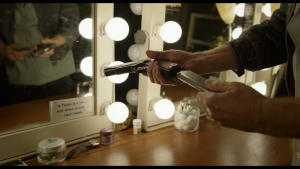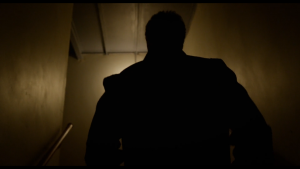Birdman’s lighting struck me as impressive because I had no idea how they did it. The camera moves through the scenes giving the illusion that the film is comprised of a single shot. This means that the lighting needs to adjust and adapt to the movement between each scene and I believe Birdman does this seamlessly.
Cinematographer Emmanuel Lubezki’s main concern going into the film was how the lighting could be achieved under the films constraints as there had never really been anything done like it. There have been many films with lengthy elaborate scenes such as Children of Men, Atonement etc. And even films like Russian Ark which are legitimately one 90 minute shot, but none that covered as wide of a variety of settings as Birdman does. Upon further research I learnt that a large portion of the lighting was manipulated digitally in post production, this included highlighting certain areas of interest, tracking objects, altering saturation etc.
Riggan and Jake are conversing by the door, the focus is drawn to Riggan by the overhead soft lighting. The door is merely a background piece and is quite dull and dimly lit.
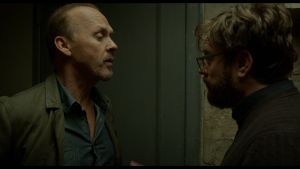 Then when Lesley enters the door to join the conversation, the lighting is adjusted to draw the focus onto her, this was achieved entirely digitally.
Then when Lesley enters the door to join the conversation, the lighting is adjusted to draw the focus onto her, this was achieved entirely digitally.
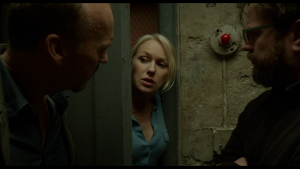 Much of the lighting in Birdman is expressive in the sense that it reveals information or creates environments to separate settings distinctly. For example when actors are waiting to go on stage in the off-stage section, the lighting is a deep blue. I believe this is a good decision as it breaks up the monotony of the grey brick walls throughout the theater. As well as allowing for the scene to be lit enough for clarity but still remain dark enough to be of a strong contrast to the activity on the stage.
Much of the lighting in Birdman is expressive in the sense that it reveals information or creates environments to separate settings distinctly. For example when actors are waiting to go on stage in the off-stage section, the lighting is a deep blue. I believe this is a good decision as it breaks up the monotony of the grey brick walls throughout the theater. As well as allowing for the scene to be lit enough for clarity but still remain dark enough to be of a strong contrast to the activity on the stage.
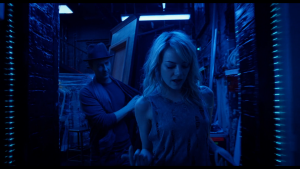 The same is applied to the audience.
The same is applied to the audience.
 Different areas of the theater are lit with similar saturation but red.
Different areas of the theater are lit with similar saturation but red.
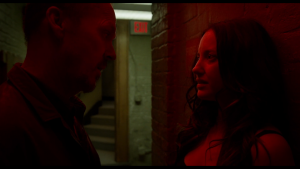 The majority of the lighting is provided by sources from in the scene, meaning house lights, lights on mirrors, hallway lights, street lights etc. which were then digitally manipulated in post production. Due to the constraints of shooting the film, a large amount of tactics and strategy went into positioning these lights or blocking the scenes around them.
The majority of the lighting is provided by sources from in the scene, meaning house lights, lights on mirrors, hallway lights, street lights etc. which were then digitally manipulated in post production. Due to the constraints of shooting the film, a large amount of tactics and strategy went into positioning these lights or blocking the scenes around them.
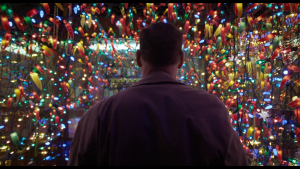 The transitions from inside to outside were apparently the most challenging and in my opinion the best aspect of the film’s lighting as a whole. In this scene Mike goes up to the roof of the theater via the dim hallway lit by a single light fixture on the wall at the top of the stairs. The scene then opens onto the roof overlooking Broadway, the lights surrounding the marquee, street lights and signage provide the soft light that radiates their faces for the scenes outdoor duration.
The transitions from inside to outside were apparently the most challenging and in my opinion the best aspect of the film’s lighting as a whole. In this scene Mike goes up to the roof of the theater via the dim hallway lit by a single light fixture on the wall at the top of the stairs. The scene then opens onto the roof overlooking Broadway, the lights surrounding the marquee, street lights and signage provide the soft light that radiates their faces for the scenes outdoor duration.
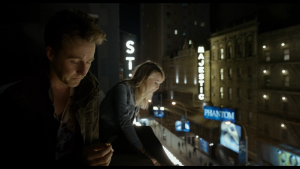 Many scenes in the film are often multi-layered in terms of lighting, meaning the back ground is vastly different from the foreground, each layer there for a reason and purposefully produced. This scene shows Riggan entering the theater from the audience entrance after he is locked out in his underwear. Riggan is strongly lit with an intense contrast to the dim, blue-toned environment. The audience is lit just enough to make out their faces as they turn as well as the contours of their heads, establishing the packed house. While the stage lit more than the audience, but nowhere near as much as Riggan, showing that he has taken the ‘spotlight’ away from the production.
Many scenes in the film are often multi-layered in terms of lighting, meaning the back ground is vastly different from the foreground, each layer there for a reason and purposefully produced. This scene shows Riggan entering the theater from the audience entrance after he is locked out in his underwear. Riggan is strongly lit with an intense contrast to the dim, blue-toned environment. The audience is lit just enough to make out their faces as they turn as well as the contours of their heads, establishing the packed house. While the stage lit more than the audience, but nowhere near as much as Riggan, showing that he has taken the ‘spotlight’ away from the production.

